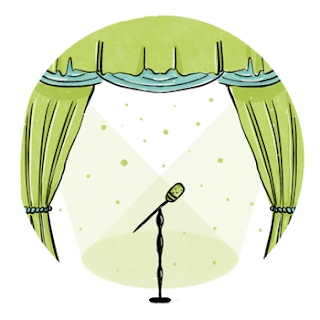Illustrators: Starting Out? How to Get Noticed...
By Lynne Chapman
I'm get lots of emails from people trying to get started in book illustration so, to save writing individual replies, here's some more general advice, this time about getting yourself noticed.
I'm get lots of emails from people trying to get started in book illustration so, to save writing individual replies, here's some more general advice, this time about getting yourself noticed.

It's following up on my post about creating a children's illustration folio, sharing what I can about the next step, and what worked for me at least.
Firstly: spend some time browsing the children's section of bookshops. Independants are best, but Waterstones will do the job. Bookshops are better than libraries for this, as it's all still selling, so never out-of-date.
Familiarise yourself with what different publishers do. Who publishes picture books? Who publishers chapter books? Which illustration techniques are used for which age groups? Who leans towards traditonal, beautiful, funny or off-the-wall?
 Note the websites of publishers whose books look a bit like what you do, then check their newest releases on-line to see what they're after right now.
Note the websites of publishers whose books look a bit like what you do, then check their newest releases on-line to see what they're after right now.
Get a copy of The Children's Writers & Artist's Yearbook (or something similar - there are a few different ones these days). This has listings of all the publishers with their contact details, as well as more advice and guidance.
Make colour prints of maybe three of your best pieces, marked with your contact details or, if you have the necessaries, design an A4 flyer, like the one above.
Post these with a short covering letter to the publishers you have researched. Unfortunately, publishers get unbelievable quantities of unsolicited material, so you have to work very hard to catch their eye. Here are a few hot tips that worked for me:
1 - Make sure you contact a named Art Director or Commissioning Editor (never send a 'to whom it may concern': it will probably go in the bin).
2 - Ensure any samples you send are produced to high quality - first impressions DO count.
 3 - Be funny or different or cute (I designed this letterhead for my covering letter, with the tied-up cat printed top-right and the fish swimming along the page bottom, featuring the header 'See me soon, or the pussycat gets it!' )
3 - Be funny or different or cute (I designed this letterhead for my covering letter, with the tied-up cat printed top-right and the fish swimming along the page bottom, featuring the header 'See me soon, or the pussycat gets it!' )
 4 - Be persistent, but not boring: send a printed sample of new work (not just the same old stuff) once a month.
4 - Be persistent, but not boring: send a printed sample of new work (not just the same old stuff) once a month.
5 - Get on-line: set up a simple website, or a Flickr portfolio, to refer publishers to (but resist the urge to pad it out with your less-good work).
6 - Be proactive: phone the art director a week later to ask if they will see you.
7 - The scatter-gun approach: do all of the above for lots of different (but relevant) publishers.
8 - Don't give up too easily: take on board any feedback you're lucky enough to get, but don't be put off by lack of success - even if you're good, it might take a while for someone to bite.
Initial Contact:
If in doubt about which individual to contact, don't be afraid to phone the publisher's switchboard to get the relevant Art Director's name. In your covering letter, tell them you would like an appointment to show them the rest of your folio. This is important, even if you're not local: I have always found that face-to-face contact is the thing that works. For me, samples sent out and website links are all about getting publishers to ultimately let me visit them at their offices, to present my work in person.
 Don't be too disappointed if the Art Director doesn't remember your samples when you phone - they get hundreds. Ask again if you can make an appointment to visit them with the rest of your work. Be ready with a simple website or Flickr page, so they can quickly check your work on-screen.
Don't be too disappointed if the Art Director doesn't remember your samples when you phone - they get hundreds. Ask again if you can make an appointment to visit them with the rest of your work. Be ready with a simple website or Flickr page, so they can quickly check your work on-screen.
OK, now the bad news - children's illustration is a very tough market to break into: there's so much competition and the standards are very high. My experience is that slogging round publishers and bombarding them with reminders about your work is the only way in.
But take heart: if your illustrations are of a high enough standard, are interesting, clever and relevant (perhaps even a little bit different, without being too off-the-scale), you should eventually get your foot in the door, if you stick at it doggedly enough.
 Watch my blog for posts about what you should expect if you are successful in getting an appointment with an Art Director. In the meantime, if you missed my talk at the conference, why not read about how I got my first book?
Watch my blog for posts about what you should expect if you are successful in getting an appointment with an Art Director. In the meantime, if you missed my talk at the conference, why not read about how I got my first book?
Good luck!
Firstly: spend some time browsing the children's section of bookshops. Independants are best, but Waterstones will do the job. Bookshops are better than libraries for this, as it's all still selling, so never out-of-date.
Familiarise yourself with what different publishers do. Who publishes picture books? Who publishers chapter books? Which illustration techniques are used for which age groups? Who leans towards traditonal, beautiful, funny or off-the-wall?
 Note the websites of publishers whose books look a bit like what you do, then check their newest releases on-line to see what they're after right now.
Note the websites of publishers whose books look a bit like what you do, then check their newest releases on-line to see what they're after right now. Get a copy of The Children's Writers & Artist's Yearbook (or something similar - there are a few different ones these days). This has listings of all the publishers with their contact details, as well as more advice and guidance.
Make colour prints of maybe three of your best pieces, marked with your contact details or, if you have the necessaries, design an A4 flyer, like the one above.
Post these with a short covering letter to the publishers you have researched. Unfortunately, publishers get unbelievable quantities of unsolicited material, so you have to work very hard to catch their eye. Here are a few hot tips that worked for me:
1 - Make sure you contact a named Art Director or Commissioning Editor (never send a 'to whom it may concern': it will probably go in the bin).
2 - Ensure any samples you send are produced to high quality - first impressions DO count.
 3 - Be funny or different or cute (I designed this letterhead for my covering letter, with the tied-up cat printed top-right and the fish swimming along the page bottom, featuring the header 'See me soon, or the pussycat gets it!' )
3 - Be funny or different or cute (I designed this letterhead for my covering letter, with the tied-up cat printed top-right and the fish swimming along the page bottom, featuring the header 'See me soon, or the pussycat gets it!' ) 4 - Be persistent, but not boring: send a printed sample of new work (not just the same old stuff) once a month.
4 - Be persistent, but not boring: send a printed sample of new work (not just the same old stuff) once a month.5 - Get on-line: set up a simple website, or a Flickr portfolio, to refer publishers to (but resist the urge to pad it out with your less-good work).
6 - Be proactive: phone the art director a week later to ask if they will see you.
7 - The scatter-gun approach: do all of the above for lots of different (but relevant) publishers.
8 - Don't give up too easily: take on board any feedback you're lucky enough to get, but don't be put off by lack of success - even if you're good, it might take a while for someone to bite.
Initial Contact:
If in doubt about which individual to contact, don't be afraid to phone the publisher's switchboard to get the relevant Art Director's name. In your covering letter, tell them you would like an appointment to show them the rest of your folio. This is important, even if you're not local: I have always found that face-to-face contact is the thing that works. For me, samples sent out and website links are all about getting publishers to ultimately let me visit them at their offices, to present my work in person.
 Don't be too disappointed if the Art Director doesn't remember your samples when you phone - they get hundreds. Ask again if you can make an appointment to visit them with the rest of your work. Be ready with a simple website or Flickr page, so they can quickly check your work on-screen.
Don't be too disappointed if the Art Director doesn't remember your samples when you phone - they get hundreds. Ask again if you can make an appointment to visit them with the rest of your work. Be ready with a simple website or Flickr page, so they can quickly check your work on-screen.OK, now the bad news - children's illustration is a very tough market to break into: there's so much competition and the standards are very high. My experience is that slogging round publishers and bombarding them with reminders about your work is the only way in.
But take heart: if your illustrations are of a high enough standard, are interesting, clever and relevant (perhaps even a little bit different, without being too off-the-scale), you should eventually get your foot in the door, if you stick at it doggedly enough.
 Watch my blog for posts about what you should expect if you are successful in getting an appointment with an Art Director. In the meantime, if you missed my talk at the conference, why not read about how I got my first book?
Watch my blog for posts about what you should expect if you are successful in getting an appointment with an Art Director. In the meantime, if you missed my talk at the conference, why not read about how I got my first book?Good luck!










Some great advice there Lynne and very nice samples, thanks.
ReplyDeleteI note your point about understanding the type of style of book and artwork that publishers are choosing to print at that moment. I've had contradictory responses from a couple of publishers .. "unfortunately your book is too similar to others on our list: and "this book is not in the 'house style' that we prefer" etc.
Meeting people face to face seems a novel idea for me now as I hardly ever leave the studio- I used to enjoy that part so maybe it's time to polish up the 'real' portfolio.